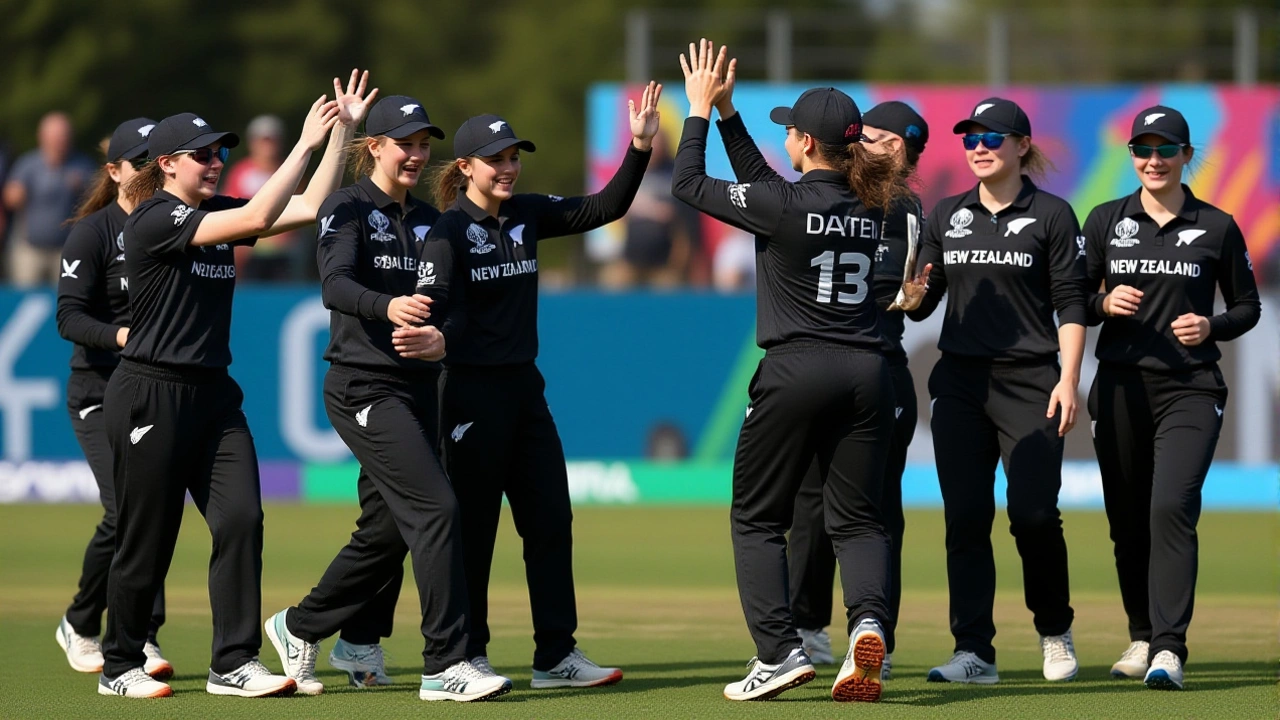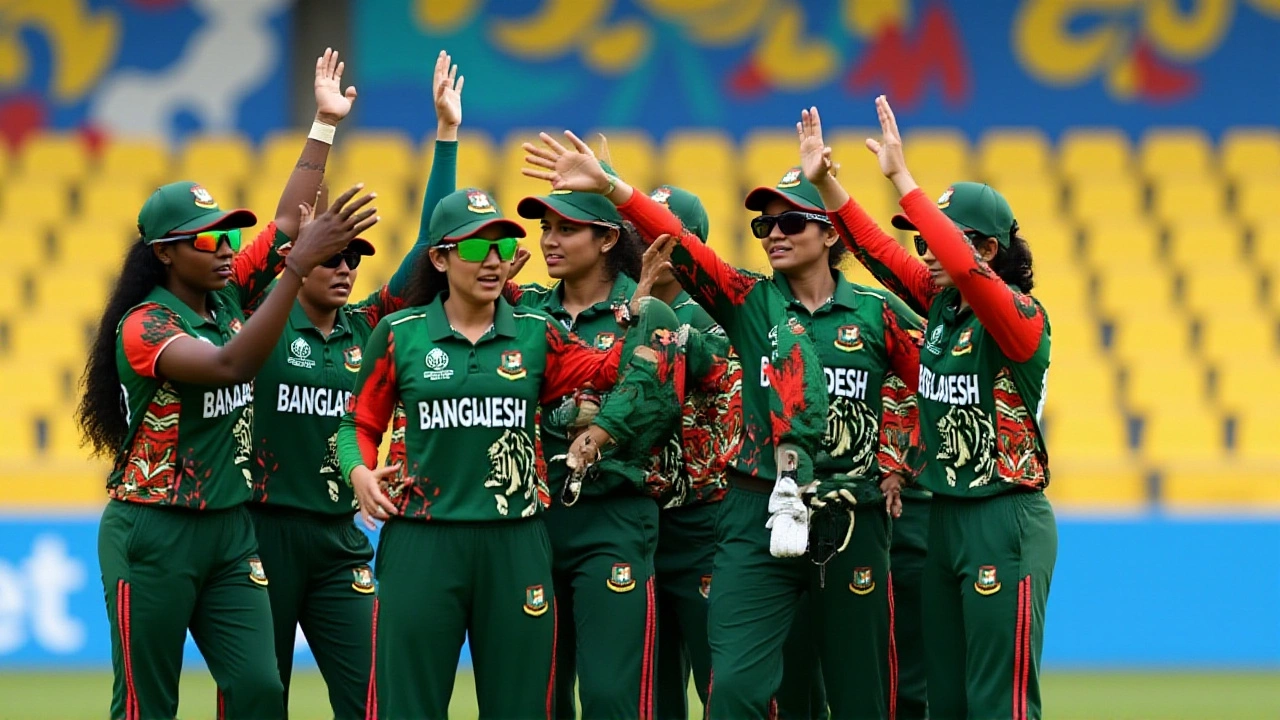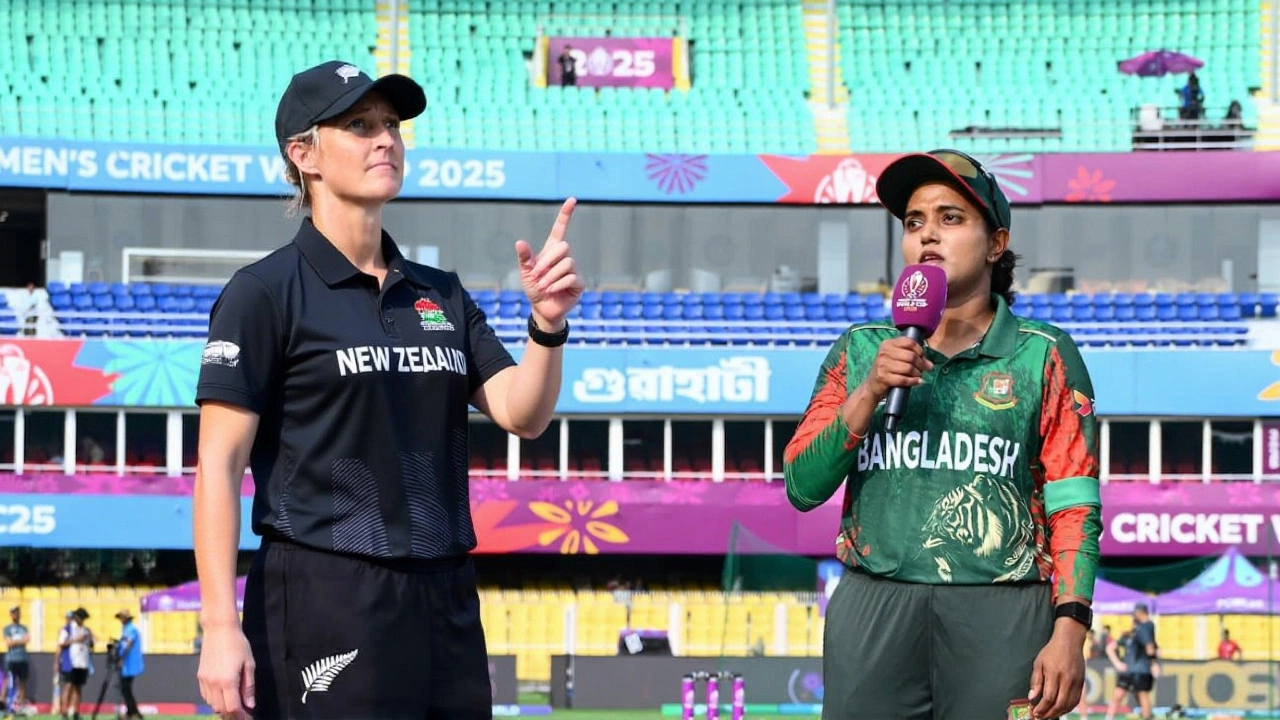When New Zealand Women’s Cricket Team finally broke its losing streak at the Women's World Cup, the result reverberated far beyond the boundary ropes. The side, led by captain Sophie Devine, hammered Bangladesh Women by exactly 100 runs at the Barsapara Cricket Stadium in Guwahati on Friday, October 10, 2025.
New Zealand posted a competitive 227 for 9 in their full 50‑over allotment, thanks to a sublime 69 from left‑hander Brooke Halliday and a punchy 63 off 85 balls from Devine herself. In reply, Bangladesh were bundled out for 127 in 39.5 overs, with the most resilient knock a modest 34 from Fahima Khatun. The victory not only marked New Zealand’s first win of the tournament after two defeats, it also kept their semifinal hopes alive while leaving Bangladesh scrambling for points.
Match Overview: Numbers and Narrative
After winning the toss, New Zealand chose to bat, a decision that paid off despite a shaky start at 38 for 3 in the 11th over. The partnership between Devine and Halliday, worth 112 runs, steadied the ship and set a platform for a respectable total. Halliday’s sweep shots, honed during a preparatory stint in Chennai, were a constant threat, while Devine’s aggressive driving kept the scoreboard moving.
Bangladesh’s innings collapsed dramatically. They were 33 for 6 after just 14 overs – a scenario rarely seen in World Cup play. The only eight boundaries they struck came when the match was already out of reach, underscoring the dominance of the New Zealand bowlers. Jess Kerr (3/21) and Lea Tahuhu (3/22) each claimed three wickets, dismantling the Bangladeshi top order. Bangladesh’s best bowler, Rabeya Khan, managed three scalps for 30 runs, but it was too little, too late.
Key Performances That Shaped the Game
Brooke Halliday’s 69 – The left‑handed batter opened with purpose, rotating the strike and unleashing powerful sweeps. Her innings accounted for nearly a third of New Zealand’s runs and earned her the Player of the Match accolade.
Sophie Devine’s 63 – The veteran’s experience showed in her calculated aggression, anchoring the middle order after early wickets fell. With a strike rate of 74.1, she also retained her position as the tournament’s leading run‑scorer.
Jess Kerr and Lea Tahuhu – Both bowlers combined for six wickets at an economy of just over five runs an over. Their disciplined lines exploited the humid Guwahati conditions, making it difficult for the Bangladeshi batters to settle.
Turning Points and Partnerships
The match hinged on two crucial moments. First, the 112‑run stand between Devine and Halliday, which turned a potential sub‑150 total into a defendable 227. Second, the early Bangladeshi batting collapse – losing six wickets for 33 runs – which effectively handed the game to New Zealand.
It’s worth noting that Suzie Bates, New Zealand’s former star, was dismissed for a duck in both opening games and almost completed an unwanted hat‑trick in the third match before an LBW call was overturned. Her silence added pressure on the younger players, making Halliday’s contribution all the more vital.

Reactions from the Camps
Post‑match, Devine praised her teammates, saying, “Everyone stepped up when it mattered. Brooke’s sweep was gold, and the bowlers kept the pressure on.” Halliday, modest as ever, added, “I just tried to play my natural game. The conditions were tough, but we adapted.”
Bangladesh’s captain, Nigar Sultana, (not marked as primary) expressed disappointment but remained optimistic: “We’ll learn from this. The pitch was challenging, and New Zealand played brilliantly. Our next game against South Africa is a must‑win.”
What This Means for the Tournament
New Zealand’s win revives their chances of reaching the semifinals. With two matches remaining – against Sri Lanka on October 14 and then a potential qualifier – they must maintain momentum. The three‑point swing also puts additional pressure on Bangladesh, who now need victories against South Africa and their final group opponent to stay alive.
The result also highlights the depth of the New Zealand side. While veteran players like Devine continue to dominate, emerging talents such as Halliday are proving they can deliver on the big stage. For Bangladesh, the defeat may trigger strategic adjustments, especially in the top order, where early wickets proved fatal.

What’s Next for Both Teams
New Zealand will travel to Colombo, Sri Lanka, for their next fixture on Tuesday, October 14. The co‑hosts will present a contrasting pitch, likely slower and spin‑friendly, testing New Zealand’s adaptability.
Bangladesh heads to Visakhapatnam to face South Africa on Monday, October 13. The South African side, bolstered by a strong pace attack, will pose a new challenge, and Bangladesh will need to rebuild confidence quickly.
Historical Context: New Zealand’s World Cup Journey
Historically, the New Zealand Women’s team has been a consistent semifinalist, winning the tournament once in 2000. Their early exits in the 2022 edition raised questions about squad depth, but the current resurgence suggests a new generation is stepping up. Halliday’s preparation in Chennai reflects a growing trend of players seeking overseas experience to fine‑tune specific shots, a strategy that paid dividends here.
Bangladesh, meanwhile, made its World Cup debut in 2017 and has gradually improved, recording notable wins against Pakistan and a narrow loss to England earlier this year. Their upset against Pakistan this tournament was a high point, but the swift swing against New Zealand underscores the fine margins at this level.
Frequently Asked Questions
How does New Zealand’s win affect their chances of reaching the semifinals?
The 100‑run victory lifts New Zealand to eight points in the group, keeping them within striking distance of the top‑two spots that guarantee semifinal berths. They now need at least one more win against Sri Lanka to secure qualification, making the upcoming match a must‑win.
What were the key factors behind Bangladesh’s collapse?
Early wickets – six down for just 33 runs – put Bangladesh on the back foot. The humid Guwahati conditions helped New Zealand bowlers swing the ball, and Bangladesh struggled to rotate the strike, leading to a low boundary count and a sub‑130 total.
Who emerged as the standout player for New Zealand?
Brooke Halliday, with her 69‑run knock featuring dominant sweeps, was the clear star. Her partnership with captain Sophie Devine turned the innings around, and she earned the Player of the Match award.
What challenges does New Zealand face in their next match against Sri Lanka?
Sri Lanka’s home pitches are slower and assist spin more than the pace‑friendly Guwahati track. New Zealand will need to adjust their batting tempo and perhaps rely more on their spinners, while keeping their disciplined bowling line to counter the Sri Lankan batting depth.
How will Bangladesh bounce back against South Africa?
Bangladesh must rebuild confidence by stabilizing their top order early and capitalising on the powerplay. Their bowlers, especially Rabeya Khan, will need to contain South Africa’s aggressive opening pair, while the batters aim for a solid partnership to set a defendable total.




